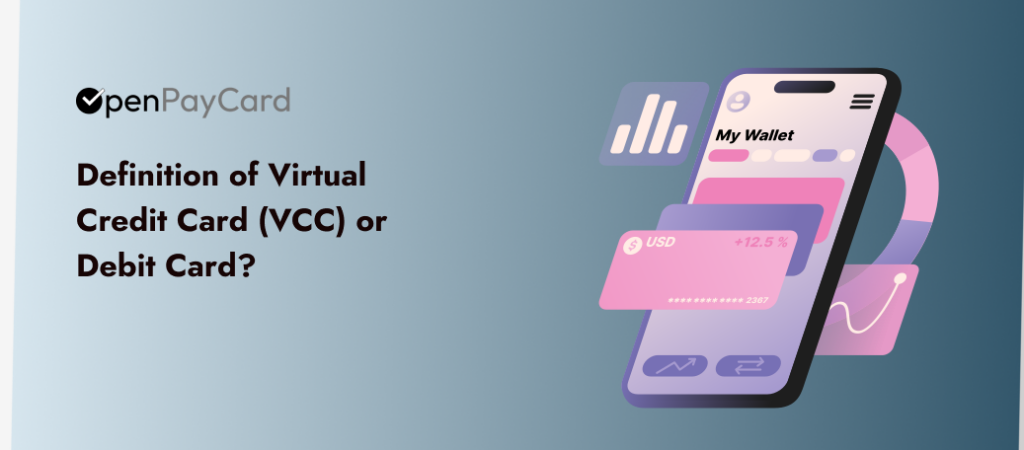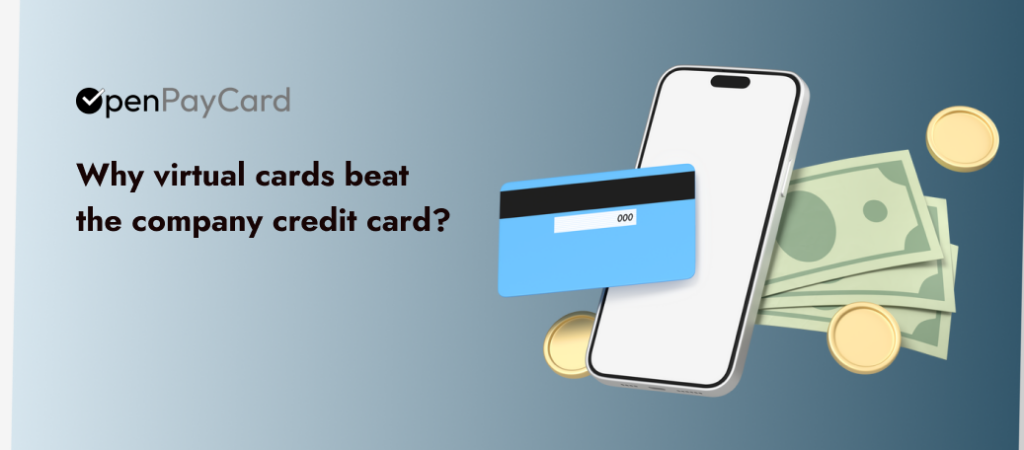Ever found yourself at the virtual checkout, wishing for a payment method as flexible and safe as your favorite yoga instructor?
Virtual credit cards are an exciting step towards smart company spending. They give businesses a more secure, more personalized, and more trackable way to pay for things online.
Frankly, it’s amazing that most companies are still hooked on the corporate credit card.
But we’re getting ahead of ourselves. We’re going to explain everything you need to know about using virtual credit cards (VCCs) for your business.
But first, there’s a more urgent question to answer:

Chapter 1: The Basics of Virtual Cards
What is a virtual credit card?
Imagine having a credit or debit card, but it lives in your phone or computer, not in your wallet. hese cards only exist online, but carry the same information as a physical bank card: card number, expiration date, and CVV code!
Virtual credit and debit cards function like their physical counterparts but exist entirely in the digital realm. They’re like the elusive unicorns of the financial world – you know they’re awesome, but you can’t physically touch them.
So, How Do They Work?
These digital dynamos are generated through your financial provider’s website or app. Each virtual card has its own card number, expiration date, and security code, just like a regular card.
But here’s the kicker: they’re often designed for one-time use or have a limited lifespan. It’s like having a secret agent in your digital wallet, ready to self-destruct after completing its mission!
Virtual cards facilitate:
- Subscriptions and subscription renewals of all types of SaaS software
- Expenses relating to business trips: hotel stays, train and plane tickets
- Occasional expenses; office supplies and miscellaneous supplies, event participation fees etc.
Basically, if you’re paying online, you should be able to do it with a virtual card.
Why Use Virtual Cards?
- Security: The first and foremost reason is security. With virtual cards, you’re less susceptible to fraud because the card details are constantly changing.
- Convenience: Easy to create, easy to use, and no need to carry a physical card.
- Control: Set spending limits or specific merchant usage. It’s like being the puppet master of your finances!
Chapter 2: The Rise of Virtual Payments
A Brief History
Did you know that the concept of virtual cards dates back to the late 90s? Yes, they’ve been around for a while, but they’ve gained massive popularity recently, thanks to the rise of online shopping and heightened security concerns. It’s like they were the sleeper hit of the financial world.
The Growth Spurt
With e-commerce booming and fraudsters getting craftier, virtual cards have become the go-to solution for many. It’s like putting on an invisibility cloak every time you shop online. Plus, with more businesses going digital, the demand for safer, more efficient payment methods has skyrocketed.
Global Adoption
From the US to Asia, Europe to Australia, virtual cards are making a global splash. It’s like the world’s financial ecosystem is getting a digital makeover!
Chapter 3: Virtual Credit Card vs Physical Cards
The Showdown
Now, let’s pit virtual cards against their physical counterparts. It’s like a friendly duel between two superheroes, each with its unique powers.
Physical Cards:
- Tangible: You can touch, feel, and show them off.
- Universal: Accepted pretty much everywhere.
- Rewards: Often come with juicy rewards and benefits.
Virtual Cards:
- Stealth Mode: High level of security and privacy.
- Customizable: Set limits and specific uses.
- Eco-Friendly: No plastic, no problem. Save the turtles, anyone?
The Verdict
While physical cards aren’t going anywhere soon, virtual cards are the new kids on the block, offering unique advantages, especially in the online realm. It’s like choosing between a classic ice cream flavor and a new, exotic one. Why not enjoy both?
Online bank virtual card
Online banks and various financial institutions offer virtual credit and debit cards that serve as convenient and secure alternatives to traditional physical cards. T
hese virtual cards are essentially digital versions of regular cards, designed primarily for online transactions, but can also be used for in-person purchases via digital wallets like Apple Pay or Google Pay.
Chapter 4: Setting Up Your Virtual Card
Getting Started
So, you’re ready to hop on the virtual card train? Choo choo! Here’s how you get started:
- Choose a Provider: This could be your bank, a openpaycard.com company, or a specialized virtual card provider.
- Sign Up: Follow the instructions to create your virtual card. It’s usually a breeze.
- Customize: Set your spending limits, expiration date, and merchant preferences.
Tips and Tricks
- Budgeting Buddy: Use virtual cards to manage your budget. Allocate a specific amount for online shopping, and once it’s gone, it’s gone!
- Travel Companion: Some virtual cards work wonders for international travel. No currency conversion fees? Yes, please!
- Subscription Manager: Use different virtual cards for different subscriptions. It’s like having a personal assistant for your digital life.

Why virtual cards beat the company credit card?
The beauty of good virtual cards is that every team member can have their own. . No more sharing or misplacing cards – because, let’s be honest, you can’t misplace what doesn’t physically exist!
Virtual cards are a dream come true in this aspect. Your team can’t leave them behind anywhere, as they’re digital. This means each team member has secure and immediate access without the usual risks.
But here’s the real kicker: since everyone has their own card, tracking online company expenditures becomes a breeze. You can easily match each expense to the correct team budget and set spending limits to ensure nobody goes overboard.
Other benefits
Virtual cards offer a convenient and secure way to manage your finances online. They function similarly to traditional debit or credit cards but exist in digital form. Here’s a summary of what I found about online banks offering virtual cards, including N26, a popular option:
- Benefits of Virtual Cards:
- Convenience: You can leave your physical wallet at home and manage everything digitally.
- Instant Control: Lock and unlock your virtual card from your phone anytime.
- Subscription Management: Use a virtual card specifically for recurring subscriptions and easily control it.
- Instant Activation: No waiting for the card to arrive in the mail; start using it immediately.
- Secure Payments: Virtual cards can be used securely online and in-store via Apple Pay and Google Pay.
- Real-Time Notifications: Get alerts on all account activities.
- Customizable Security Settings: Turn on or off various payment options like online payments, ATM withdrawals, and foreign transactions.
- Advanced Security Features: Benefit from features like 3D Secure for extra fraud protection.
- N26 Virtual Card Offerings:
- Free Virtual Card for Premium Customers: N26 premium customers get a free virtual card with its own number, enhancing online shopping security.
- Different Account Plans:
- N26 Smart: Offers a free virtual card, sub-accounts, phone support, and more for €4.90/month.
- N26 You: Includes travel benefits and insurance coverages for €9.90/month.
- N26 Metal: A premium account with additional benefits, including a metal card, for €16.90/month.
- Virtual Card Usability: Can be used for online purchases or added to digital wallets for contactless in-store purchases.
- Safety: Virtual cards are electronically encrypted for secure transactions.
- How to Get a Virtual Card with N26:
- Go to the Cards tab in the N26 app.
- Select ‘Virtual’ and follow the prompts to generate a virtual card.
- Differences Between Card Types:
- Prepaid Debit Card vs Virtual Card: A prepaid debit card is not linked to a bank account and needs to be topped up, whereas a virtual card is linked to your bank account.
- Virtual Card vs Digital Card: A virtual card exists only in digital form and may have a different number from the physical card. A digital card is a digital version of your physical card.
- Additional Features:
- Premium N26 accounts allow adding a digital version of the physical N26 debit Mastercard to your digital wallet, plus an extra virtual card with its own number.
Overall, virtual cards like those offered by N26 provide a blend of convenience, security, and flexibility, making them a valuable tool for modern financial management
Where to get a VCC?
Currently, companies looking to acquire a virtual payment card have two primary sources: traditional banks and startups like Openpaycard.com Most Reliable Card for Worldwide Payment. Each of these offers distinct features and functionalities.
1. Through a Traditional Bank
Choosing a bank for virtual cards typically involves the company’s head and the financial director utilizing an online tool to generate virtual cards. These tools provide essential details like the card number, expiration dates, and CVV codes, which can be shared with employees for making online purchases.
2. Via a Spend Management Platform
Alternatively, a company might opt for a spend management platform such as openpaycard.com similar services. This option tends to streamline the process and offers additional benefits for both employees and the finance team.
Why is this a better option? Platforms like openpaycard.com encompass the entire purchasing cycle – from initiating a purchase request to making the payment and reconciling accounts.
In real terms
Here’s how it works with a service like openpycard.com : An employee initiates a purchase request via the platform. Once approved by a manager, financial director, or head of the organization, a virtual card is instantly generated. The employee then receives a real-time notification, indicating they can proceed with using the virtual card for their intended purchase.
This streamlined workflow not only enhances employee autonomy but also ensures that finance teams maintain oversight and control.
Choose virtual cards for your company
virtual credit and debit cards are the superheroes of the digital payment world. They offer security, flexibility, and control, all wrapped up in a neat, digital package.
If your goals are to save the company time and effort, while at the same time making your spending more secure and easier to control, then virtual cards are just what you need.
And the best way to get them is with a spend management platform like Openpaycard.com.
So, why not give them a try? After all, in the ever-evolving world of finance, staying ahead of the curve is always a smart move!
Remember, in a world where everything is going digital, why should your wallet be any different? Happy (and safe) spending!






![How to Buy EzzoCard in 3 Simple Steps [Secret Method]](https://openpaycard.com/wp-content/uploads/2023/01/How-to-Buy-EzzoCard-in-3-Simple-Steps-Secret-Method-1-300x156.png)

